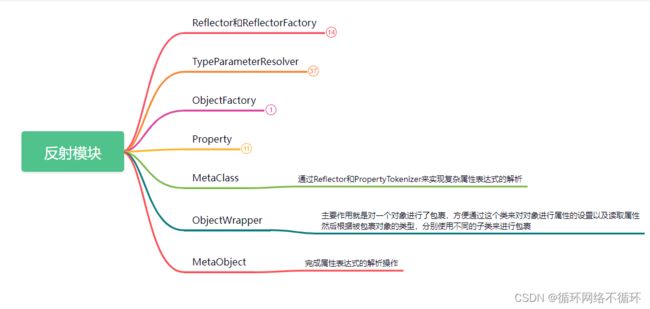(四)MyBatis源码阅读: MyBatis基础模块-反射模块
一、概述
MyBatis在进行参数处理、结果集映射等操作时会使用到大量的反射操作,Java中的反射功能虽然强大,但是代码编写起来比较复杂且容易出错,为了简化反射操作的相关代码,MyBatis提供了专门的反射模块,该模块位于org.apache.ibatis.reflection包下,它对常见的反射操作做了进一步的封装,提供了更加简洁方便的反射API。
二、反射模块
(一)Reflector
1、属性
首先来看下Reflector中提供的相关属性的含义
// 对应的Class 类型
private final Class type;
// 可读属性的名称集合 可读属性就是存在 getter方法的属性,初始值为null
private final String[] readablePropertyNames;
// 可写属性的名称集合 可写属性就是存在 setter方法的属性,初始值为null
private final String[] writablePropertyNames;
// 记录了属性相应的setter方法,key是属性名称,value是Invoker方法
// 他是对setter方法对应Method对象的封装
private final Map setMethods = new HashMap<>();
// 属性相应的getter方法
private final Map getMethods = new HashMap<>();
// 记录了相应setter方法的参数类型,key是属性名称 value是setter方法的参数类型
private final Map> setTypes = new HashMap<>();
// 和上面的对应
private final Map> getTypes = new HashMap<>();
// 记录了默认的构造方法
private Constructor defaultConstructor;
// 记录了所有属性名称的集合
private Map caseInsensitivePropertyMap = new HashMap<>(); 2、构造方法
在Reflector的构造器中会完成相关的属性的初始化操作
// 解析指定的Class类型 并填充上述的集合信息
public Reflector(Class clazz) {
type = clazz; // 初始化 type字段
addDefaultConstructor(clazz);// 设置默认的构造方法
addGetMethods(clazz);// 获取getter方法
addSetMethods(clazz); // 获取setter方法
addFields(clazz); // 处理没有getter/setter方法的字段
// 初始化 可读属性名称集合
readablePropertyNames = getMethods.keySet().toArray(new String[0]);
// 初始化 可写属性名称集合
writablePropertyNames = setMethods.keySet().toArray(new String[0]);
// caseInsensitivePropertyMap记录了所有的可读和可写属性的名称 也就是记录了所有的属性名称
for (String propName : readablePropertyNames) {
// 属性名称转大写
caseInsensitivePropertyMap.put(propName.toUpperCase(Locale.ENGLISH), propName);
}
for (String propName : writablePropertyNames) {
// 属性名称转大写
caseInsensitivePropertyMap.put(propName.toUpperCase(Locale.ENGLISH), propName);
}
}(二)ReflectorFactory
ReflectorFactory接口主要实现了对Reflector对象的创建和缓存。接口的定义如下:
public interface ReflectorFactory {
// 检测该ReflectorFactory是否缓存了Reflector对象
boolean isClassCacheEnabled();
// 设置是否缓存Reflector对象
void setClassCacheEnabled(boolean classCacheEnabled);
// 创建指定了Class的Reflector对象
Reflector findForClass(Class type);
}然后我们来看看它的具体实现
1、DefaultReflectorFactory
MyBatis只为该接口提供了DefaultReflectorFactory这一个实现类。他与Reflector的关系如下:
DefaultReflectorFactory中的实现,代码比较简单,我们直接贴出来
public class DefaultReflectorFactory implements ReflectorFactory {
private boolean classCacheEnabled = true;
// 实现对 Reflector 对象的缓存
private final ConcurrentMap, Reflector> reflectorMap = new ConcurrentHashMap<>();
public DefaultReflectorFactory() {
}
@Override
public boolean isClassCacheEnabled() {
return classCacheEnabled;
}
@Override
public void setClassCacheEnabled(boolean classCacheEnabled) {
this.classCacheEnabled = classCacheEnabled;
}
@Override
public Reflector findForClass(Class type) {
if (classCacheEnabled) {// 开启缓存
// synchronized (type) removed see issue #461
return reflectorMap.computeIfAbsent(type, Reflector::new);
} else {
// 没有开启缓存就直接创建
return new Reflector(type);
}
}
}
(三)Invoker
针对于Class中Field和Method的调用,在MyBatis中封装了Invoker对象来统一处理(有使用到适配器模式)
/**
* @author Clinton Begin
*/
public interface Invoker {
// 执行Field或者Method
Object invoke(Object target, Object[] args) throws IllegalAccessException, InvocationTargetException;
// 返回属性相应的类型
Class getType();
}该接口有对应的三个实现
(四)MetaClass
在Reflector中可以针对普通的属性操作,但是如果出现了比较复杂的属性,比如 private Person person; 这种,我们要查找的表达式 person.userName.针对这种表达式的处理,这时就可以通过MetaClass来处理了。我们来看看主要的属性和构造方法。
/**
* 通过 Reflector 和 ReflectorFactory 的组合使用 实现对复杂的属性表达式的解析
* @author Clinton Begin
*/
public class MetaClass {
// 缓存 Reflector
private final ReflectorFactory reflectorFactory;
// 创建 MetaClass时 会指定一个Class reflector会记录该类的相关信息
private final Reflector reflector;
private MetaClass(Class type, ReflectorFactory reflectorFactory) {
this.reflectorFactory = reflectorFactory;
this.reflector = reflectorFactory.findForClass(type);
}
// ....
}(五)MetaObject
我们可以通过MetaObject对象解析复杂的表达式来对提供的对象进行操作。具体的通过案例来演示会更直观些
@Test
public void shouldGetAndSetField() {
RichType rich = new RichType();
MetaObject meta = SystemMetaObject.forObject(rich);
meta.setValue("richField", "foo");
System.out.println(meta.getValue("richField"));
}
@Test
public void shouldGetAndSetNestedField() {
RichType rich = new RichType();
MetaObject meta = SystemMetaObject.forObject(rich);
meta.setValue("richType.richField", "foo");
System.out.println(meta.getValue("richType.richField"));
}
@Test
public void shouldGetAndSetMapPairUsingArraySyntax() {
RichType rich = new RichType();
MetaObject meta = SystemMetaObject.forObject(rich);
meta.setValue("richMap[key]", "foo");
System.out.println(meta.getValue("richMap[key]"));
}以上三个方法的输出结果都是foo
三、反射模块的应用
(一)SqlSessionFactory
在创建SqlSessionFactory操作的时候会完成Configuration对象的创建,而在Configuration中默认定义的ReflectorFactory的实现就是DefaultReflectorFactory对象。然后在解析全局配置文件的代码中,给用户提供了ReflectorFactory的扩展,也就是我们在全局配置文件中可以通reflectorFactory标签来使用我们自定义的ReflectorFactory。
(二)执行SQL
在Statement获取结果集后,在做结果集映射的使用有使用到,在DefaultResultSetHandler的createResultObject方法中。
private Object createResultObject(ResultSetWrapper rsw, ResultMap resultMap, ResultLoaderMap lazyLoader, String columnPrefix) throws SQLException {
this.useConstructorMappings = false; // reset previous mapping result 标识是否使用 构造函数创建对象
// 记录构造函数的参数类型
final List> constructorArgTypes = new ArrayList<>();
// 记录构造函数的实参
final List 然后在DefaultResultSetHandler的getRowValue方法中在做自动映射的时候
private Object getRowValue(ResultSetWrapper rsw, ResultMap resultMap, CacheKey combinedKey, String columnPrefix, Object partialObject) throws SQLException {
final String resultMapId = resultMap.getId();
Object rowValue = partialObject;
if (rowValue != null) {
final MetaObject metaObject = configuration.newMetaObject(rowValue);
putAncestor(rowValue, resultMapId);
applyNestedResultMappings(rsw, resultMap, metaObject, columnPrefix, combinedKey, false);
ancestorObjects.remove(resultMapId);
} else {
final ResultLoaderMap lazyLoader = new ResultLoaderMap();
rowValue = createResultObject(rsw, resultMap, lazyLoader, columnPrefix);
if (rowValue != null && !hasTypeHandlerForResultObject(rsw, resultMap.getType())) {
final MetaObject metaObject = configuration.newMetaObject(rowValue);
boolean foundValues = this.useConstructorMappings;
if (shouldApplyAutomaticMappings(resultMap, true)) {
foundValues = applyAutomaticMappings(rsw, resultMap, metaObject, columnPrefix) || foundValues;
}
foundValues = applyPropertyMappings(rsw, resultMap, metaObject, lazyLoader, columnPrefix) || foundValues;
putAncestor(rowValue, resultMapId);
foundValues = applyNestedResultMappings(rsw, resultMap, metaObject, columnPrefix, combinedKey, true) || foundValues;
ancestorObjects.remove(resultMapId);
foundValues = lazyLoader.size() > 0 || foundValues;
rowValue = foundValues || configuration.isReturnInstanceForEmptyRow() ? rowValue : null;
}
if (combinedKey != CacheKey.NULL_CACHE_KEY) {
nestedResultObjects.put(combinedKey, rowValue);
}
}
return rowValue;
}继续跟踪,在createAutomaticMappings方法中
private boolean applyAutomaticMappings(ResultSetWrapper rsw, ResultMap resultMap, MetaObject metaObject, String columnPrefix) throws SQLException {
// 获取ResultSet中存在,但在ResultMap中没有明确映射的列
List autoMapping = createAutomaticMappings(rsw, resultMap, metaObject, columnPrefix);
boolean foundValues = false;
if (!autoMapping.isEmpty()) {
for (UnMappedColumnAutoMapping mapping : autoMapping) {
// 使用TypeHandler 获取自定映射的列值
final Object value = mapping.typeHandler.getResult(rsw.getResultSet(), mapping.column);
if (value != null) {
foundValues = true;
}
if (value != null || (configuration.isCallSettersOnNulls() && !mapping.primitive)) {
// gcode issue #377, call setter on nulls (value is not 'found')
// 将自动映射的属性值设置到结果对象中
metaObject.setValue(mapping.property, value);
}
}
}
return foundValues;
} 



